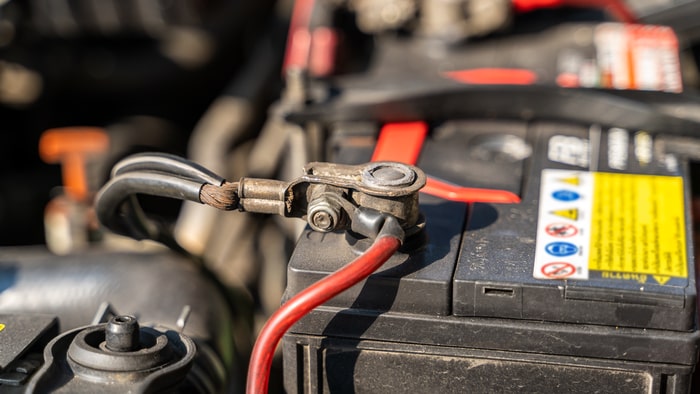Importance of Battery Terminal Connection Order
Safety Considerations
Connecting and disconnecting battery terminals in the correct order is essential to prevent electrical shorts, sparks, and potential injury. The battery terminals are labeled as positive (+) and negative (-), with the positive terminal usually covered in red and the negative in black.
- Preventing Short Circuits: If you disconnect the positive terminal first while the negative terminal is still connected, any tool that touches the vehicle’s metal body can create a short circuit, leading to sparks or battery damage.
- Minimizing Risks: By disconnecting the negative terminal first, you eliminate the risk of accidentally completing a circuit that could lead to an electrical shock or explosion.
- Proper Reconnection: When reconnecting, the positive terminal should be connected first to ensure that the circuit is completed safely without risk of shorting.
Overview of Battery Terminals
| Terminal | Color | Symbol | Function |
|---|---|---|---|
| Positive | Red | + | Supplies power to the vehicle’s electrical systems |
| Negative | Black | – | Grounds the electrical system, completing the circuit |
Step-by-Step Guide to Disconnecting a Car Battery
Tools Needed
- Safety goggles
- Gloves
- Socket wrench or wrench kit
- Cloth or non-conductive cover for the positive terminal
Procedure
- Turn Off the Engine
Ensure the vehicle is turned off and remove the keys from the ignition to avoid accidental starting. - Locate the Battery
Find the battery, typically located in the engine compartment, but sometimes in the trunk or under the rear seat. - Disconnect the Negative Terminal
- Using a socket wrench, loosen the nut on the negative terminal (black).
- Carefully lift the cable off the battery post and set it aside, ensuring it does not touch the battery or any metal surfaces.
- Disconnect the Positive Terminal
- Loosen the nut on the positive terminal (red).
- Wrap the positive terminal with a cloth to prevent accidental contact with metal.
- Remove the positive cable from the battery post.
- Remove the Battery
- If applicable, loosen any battery hold-downs securing the battery in place.
- Carefully lift the battery out of the tray, keeping it level to prevent acid spillage.
Step-by-Step Guide to Connecting a Car Battery
Procedure
- Inspect the Terminals
Before connecting, check the terminals for corrosion or dirt. Clean them with a mixture of baking soda and water if necessary. - Place the New Battery
If replacing, position the new battery in the tray and secure it with any hold-downs. - Reconnect the Positive Terminal
- Remove the cloth from the positive terminal.
- Attach the positive cable to the positive battery post and tighten the nut securely.
- Reconnect the Negative Terminal
- Attach the negative cable to the negative battery post and tighten the nut securely.
- Final Checks
Ensure all connections are tight and that there are no tools left near the battery. Start the vehicle to check that everything is functioning correctly.
FAQ Section
Why is it important to disconnect the negative terminal first?
Disconnecting the negative terminal first helps to prevent short circuits. If the positive terminal is disconnected first while the negative is still connected, any tool that touches the vehicle’s metal can complete a circuit and cause sparks or damage.
Can I connect the terminals in any order?
No, it is crucial to connect the positive terminal first and the negative terminal last to ensure safety and prevent electrical shorts.
What tools do I need to disconnect a car battery?
You will need safety goggles, gloves, a socket wrench or wrench kit, and possibly a cloth to cover the positive terminal.
What should I do if I see corrosion on the terminals?
Clean the terminals using a mixture of baking soda and water, scrubbing gently with a brush. Ensure they are dry before reconnecting.
Is it safe to disconnect the battery while the engine is running?
No, you should never attempt to disconnect the battery while the engine is running, as this can lead to serious injury or damage to the vehicle’s electrical system.
What happens if I connect the terminals incorrectly?
Connecting the terminals incorrectly can cause sparks, damage to the battery, and potentially harm the vehicle’s electrical systems.
How can I tell which terminal is positive and which is negative?
The positive terminal is usually marked with a plus sign (+) and is typically red, while the negative terminal is marked with a minus sign (-) and is usually black.
Can I use any wrench to disconnect the battery?
It is best to use a socket wrench or an appropriate wrench that fits the terminal nuts securely to avoid stripping them.
What should I do if my battery is leaking?
If you notice any signs of leakage, do not attempt to handle the battery. Contact a professional for assistance, as battery acid can be hazardous.
Conclusion
Understanding the correct procedure for connecting and disconnecting a car battery is essential for safety and efficiency. By following the outlined steps and adhering to the recommended order of operations, you can minimize risks associated with electrical shorts and ensure a smooth battery maintenance process. Always prioritize safety by wearing protective gear and consulting your vehicle’s manual for specific instructions.For further reading on battery maintenance and safety practices, you can refer to the following resource: Wikipedia – Lead-Acid Battery.This guide provides a comprehensive overview of the necessary steps and considerations involved in working with car batteries, ensuring that you can perform these tasks safely and effectively.



